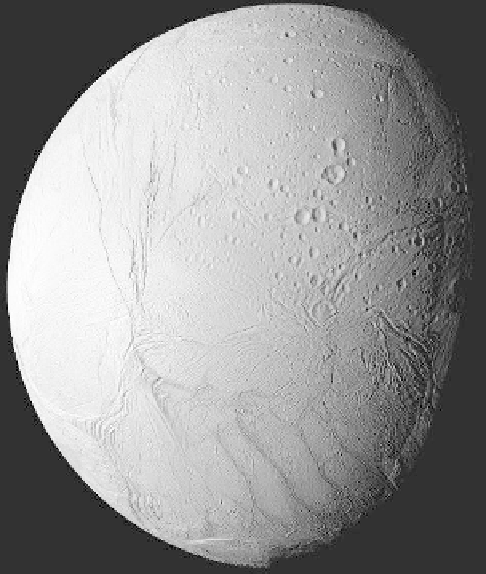Geology Reference
In-Depth Information
Figure 9.14. A radar image of linear dunes in the Aztlan region of
Titan. The dunes are thought to consist of grains of ice a few hundred
micrometers in diameter. From the pattern of the dunes and their
interaction with topographic highs (the radar-bright features), winds
are inferred to blow from the west (left) to the east (right). The area
shown is about 275 km by 250 km (NASA Cassini PIA09182 part).
Figure 9.15. A Cassini image of Enceladus showing cratered terrain
(upper right), smooth plains, and the set of parallel fractures
(southern or lower part of image) referred to as
“
tiger-stripe
”
terrain
(NASA PIA 06254).
>Nearly all are linear dunes, a non-genetic term that
simply indicates their pattern as seen in map view. While
many planetologists consider the Titan features to be
longitudinal dunes, the image resolution is not adequate
for this specific identification. Where the dunes interact
with local hills, most terminate abruptly on the western
sides; they appear to wrap around the topography and to
have diffuse patterns on the east sides of the hills. These
patterns suggest that formative winds are from the west to
the east. Moreover, if they are longitudinal dunes, this
would suggest that two wind regimes are dominant and
meet at an acute angle, resulting in the duneform
(
Fig. 3.39
). The puzzle, however, is that atmospheric
models predict dominant winds in the opposite direction;
this is a subject of current research.
Aeolian processes require a supply of small particles
and winds of suf
cient strength to move them. Winds
measured by the Huygens probe are well within the
range to transport grains, but the source of sand-size
particles is poorly understood. In principle, such sizes
are generated by volcanic, tectonic, impact, and other
processes. Certainly, these processes have occurred on
Titan, but how would ice behave in the presence of these
agents? This, too, is a subject of current study.
In summary, the processes that have shaped Titan
'
ssur-
face are very familiar to terrestrial geologists, but the cold,
low-gravity environment, coupled with the non-silicate
composition of the crust, poses interesting challenges if
we are to understand the evolution of Titan
'
ssurface.It
has been argued that, in some respects, Titan is analogous to
a primordial Earth, especially with regard to the origin of
life, making Titan a high priority for future exploration.
9.6 Enceladus
Enceladus is an extremely bright object because of its pre-
dominantly ice surface. When it was
rstseenindetailin
Voyager images of about 1 km per pixel, Enceladus posed an
interesting problem: two provinces were seen globally, a
heavily cratered terrain and a much younger terrain with a
paucity of craters (
Fig. 9.15
). This suggested that recent
resurfacing had occurred, but because the moon is only
~504 km in diameter, it seemed unlikely that such a small
object could experience endogenic processes such as cryo-
volcanism. As is often the case in planetary science, this was
a faulty assumption, as was shown by the Cassini discovery





